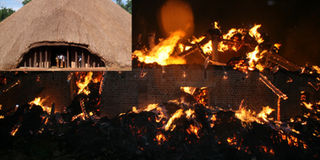Uganda loses key heritage site

Inset are the tombs before they were burnt down on March 16. Photo by Joseph Kiggundu
What you need to know:
While Buganda Kingdom has promised to rebuild the tombs, a process that President Museveni says his government to play a role in, the damage on many historical items in the fire means that one of Uganda’s most significant historical, cultural and tourist sites will never be the same again.
Kampala
The Kasubi tombs, which were torched Tuesday by a mysterious fire, are the Ugandan equivalent of the Egyptian pyramids, the ancient masonry structures that were constructed as burial grounds for the North African country’s Pharaohs.
The pyramids tower over the Kasubi tombs in size and international stature, but the two share a common denominator in the fact that they are both inscribed on the exclusive United Nations Education Scientific and Cultural Organisation (UNESCO) list of world heritage sites. That tribute elevates Kasubi, where four previous Kabakas (kings) of Buganda Kingdom were buried in the dome-shaped main building named Muzibu Azaala Mpanga, to more than just an embodiment of the values of belief, spirituality, continuity and identity of Uganda’s largest cultural institution.
Kasubi was initially the palace for Kabaka Mutesa I (1835-1884), who was buried at his palace, thereby breaking the tradition of being buried in his former palace. His son Mwanga II (1867-1903) was buried in the same palace, which went against the tradition of burying Kabakas in different places. That marked out Kasubi as an important cultural site, leading to the burial of two other Kabakas; Daudi Chwa II (1896-1939) and Muteesa II (1924-1969). Describing the 30-hectare tomb site as “a masterpiece of human creativity both in its conception and execution,” UNESCO says its spatial organisation represents the best extant example of a Buganda palace/architectural ensemble.
The inside of the tomb that burnt was partitioned with a huge bark cloth that separated the “sacred forest” where the four royal graves lie. The entrance to the sacred forest was limited to the widows of the Kabakas, the royal family, the Nalinya (the Kabaka’s official sister after his death who oversees all traditional custodians), and the Katikkiro (Prime Minister).
The greatest material loss at the tombs is perhaps the power insignias like the drums, spears, shields, medals and photographs of the Kabakas buried there, which adorned the inside of the house. The floor was also covered by a thick layer of lemon grass and palm leaves mats, and the entire structure was supported by straight wooded poles wrapped in backcloth.
While Buganda Kingdom has promised to rebuild the tombs, a process that President Museveni says his government to play a role in, the damage on many historical items in the fire means that one of Uganda’s most significant historical, cultural and tourist sites will never be the same again.
Brief description
The Tombs at Kasubi constitute a site embracing almost 30 hectares of hillside within Kampala District. Most of the site is agricultural, farmed by traditional methods.
At its core on the hilltop is the former palace of the Kabakas of Buganda, built in 1882 and converted into the royal burial ground in 1884.
Four royal tombs now lie within the Muzibu Azaala Mpanga, the main building, which is circular and surmounted by a dome.
It is a major example of an architectural achievement in organic materials, principally wood, thatch, reed, wattle and daub. The site’s main significance lies, however, in its intangible values of belief, spirituality, continuity and identity.
The actual site is a traditional circular house. There are a bunch of smaller circular houses built around it which belong to the Kabaka’s widows.Brief description



